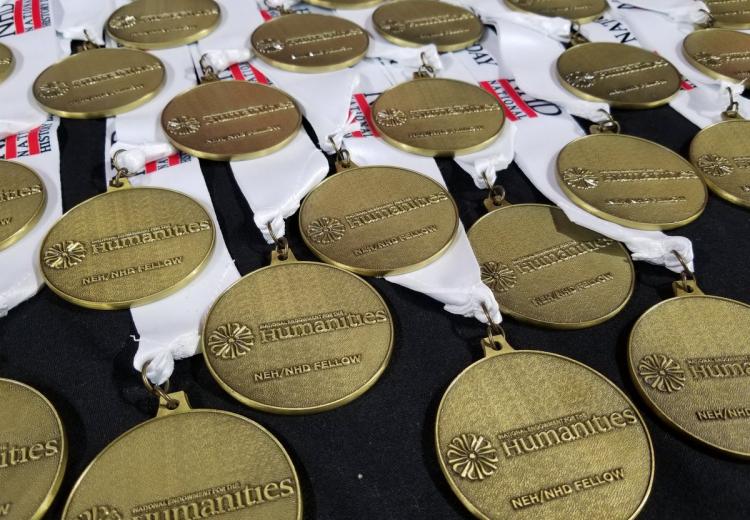Each year at the National History Day competition the National Endowment for the Humanities awards the Chronicling America: Historic American Newspapers Prize in both the Junior and Senior divisions to an outstanding entry in any category that utilizes the newspaper resources that are available through the Chronicling America database.
You may already know about Chronicling America, the long-standing partnership between the Library of Congress and the National Endowment for the Humanities, which provides free access to millions of digitalized pages of America’s historic newspapers. Users can search and view newspaper pages from 1770–1963 and find information about American newspapers published between 1690–present using the National Digital Newspaper Program. EDSITEment offers research ideas and a feature on using special collections included within Chronicling America at our Chronicling America Teacher's Guide.
Curating Content for the Classroom: The Problem of Bias
Reading old newspapers opens a window into a world with a multiplicity of values, many of which are sharply different from ours. The unfiltered news and commentary of yesterday holds wonders but also requires a teacher’s sharp editorial guidance to be most effective. The existence of racial or gender bias in articles or advertisements that would have raised no concern back in the day, may make modern students or their parents uncomfortable. Be prepared to encounter such moments and to use them to help students understand their own beliefs and values, as well as to learn how complex an encounter with real history is. To assist you in this process, we have linked to a short guide to teaching sensitive material.
Moreover, most historic papers were affiliated with a particular political party and consequently have a strongly partisan editorial policy, in the literal sense. Happily through the tools available, students can easily learn about—and from—the distinctive perspectives of these newspapers. Chronicling America makes it relatively easy to discover the history and political profile of the paper under examination by way of the “about” section that accompanies almost every newspaper title.
For example, the “about” section of The Toiler gives a fascinating “biography” of the “Official Organ of the Communist Labor Party of Ohio.” Though short lived, it was merged with another title to form what became known as the Daily Worker, the Communist Party of America’s national paper. For an introduction to the partisanship of 19th- and early 20th-century newspapers and an interesting argument about the positive side of this partisanship, see the article "The Fall and Rise of Partisan Journalism."
Teaching Diverse Perspectives with Historic Newspapers
Special collections of newspapers serving particular identities and interests are an especially exciting and revelatory part of Chronicling America. Irish, Latin American, and Jewish newspapers have now been joined by a significant number of German language newspapers and newspapers serving Indigenous communities.
Most impressively, there are now more that one hundred African American newspapers from thirty states and the District of Columbia. South Carolina alone is represented by eleven papers! These papers allow us to trace the daily lives and opinions of Black people from the days of Emancipation and Reconstruction through the establishment of Jim Crow, World War I, and the Great Migration.
A feature essay on using these newspaper collections and what the perspectives they bring to U.S. history provide is available at our Chronicling America Teacher's Guide. Or, you can go directly to Chronicling America and use the “All Digitalized Newspapers” tab in the search menu.
The “Golden Age” of Newspapers
The greatest concentration of Chronicling America material currently available online runs from 1900–1922, offering an unrivaled view of the heyday of what historian Doris Kearns Goodwin has called the “golden age of journalism.” Here one can immerse oneself in the Populist and Progressive Eras, the leadership of Presidents Teddy Roosevelt and Woodrow Wilson, and the return to “normalcy” under President Warren Harding. On the world stage, this is the period of the Great War, the Russian Revolution, and the worldwide influenza pandemic—all of which are covered in great and fascinating detail in these pages.
The date range and states included in Chronicling America’s newspapers collection are constantly expanding. You can begin to explore the riches of this database by simply searching Chronicling America by keyword or by using the suggested list of topics arranged by subject, decade or large theme.
Teaching and Researching with Chronicling America
EDSITEment provides a robust collection of resources and lessons that incorporate Chronicling America. Teachers and students will find these materials helpful in navigating the database, creating research questions on a given NHD theme or project topic, and incorporating historic newspapers into classroom discussions and projects.
Chronicling and Mapping the Women's Suffrage Movement—This lesson brings together digital mapping and the Chronicling America newspaper database as part of an inquiry into how and where the women’s suffrage movement took place in the United States.
Thomas Edison's Inventions in the 1900s and Today: From "New" to You!—Students can trace the history of Thomas Edison's inventions through EDSITEment's lesson plan and this fascinating article on the history of the incandescent bulb from Chronicling America.
The Industrial Age in America: Sweatshops, Steel Mills, and Factories—Technological innovation isn't always entirely beneficial. Read Upton Sinclair's first hand account of the abuse that accompanied the industrial revolution while engaging in this lesson on the era of industrialization in the U.S.
Chronicling America: Uncovering a World at War—This lesson gives students the opportunity to interact with historical newspapers from the WWI era available through Chronicling America and engage in dialogue as they decide: Should the United States remain neutral or join the fight?

